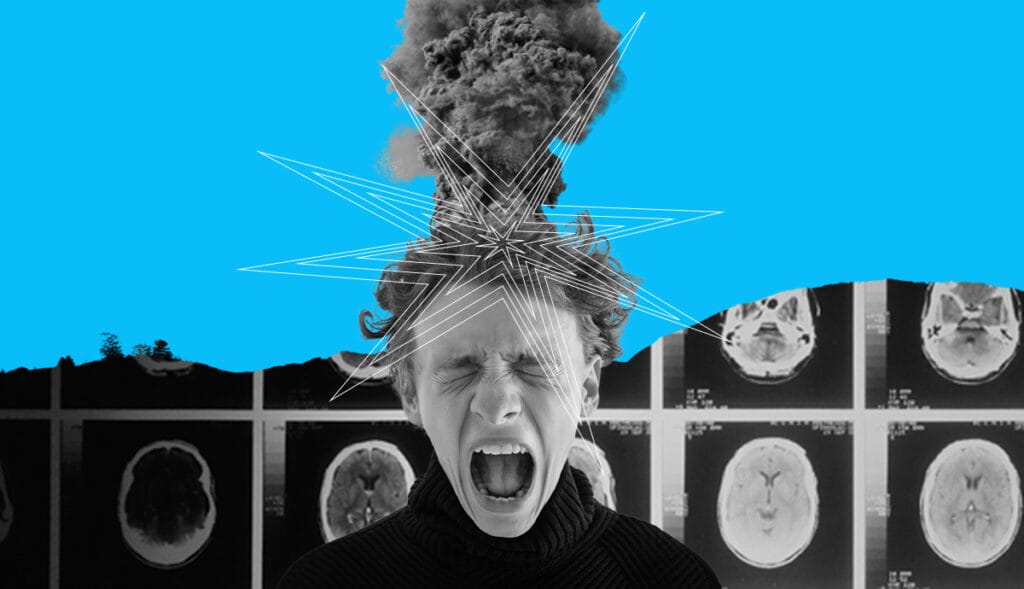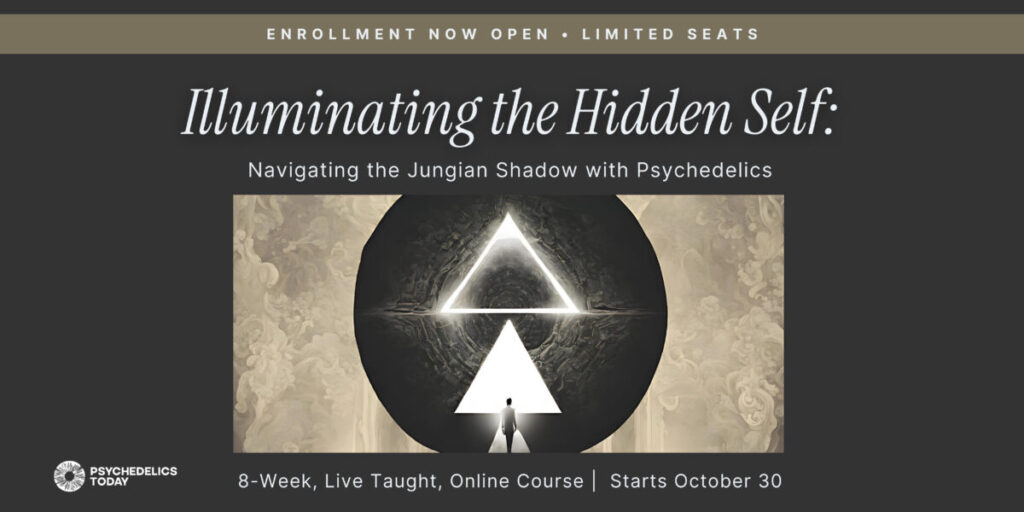Psychedelic shadow work is central to the transformative potential of entheogens, helping us confront and integrate hidden parts of our psyche.
Psychedelic experiences, in and of themselves, do not create lasting change by chance or passively – they require active participation. Entheogens can open the doors to the unconscious and invite us to make meaning from its contents. Shadow work supports this soul-manifesting process by helping us embrace our hidden parts so that we may become fully actualized.

What is the Shadow?
Psychotherapist Carl G. Jung coined the term “shadow” to describe the instincts, drives, and emotions we consciously and unknowingly repress but whose malignant impacts we feel.
The shadow contains our darkest secrets, covert desires, and obscured emotions. It holds our greatest fears and our fullest potential; it is the source of intuition, wisdom, and individuation. And yet, most of us reject it because we fear the truth – that we are both good and evil, loving and hateful, angry and calm, devastated and joyful, masculine and feminine.
“The shadow is a living part of the personality and therefore, wants to live with it in some form. It cannot be argued out of existence or rationalized into harmlessness,” said Jung in Archetypes and the Collective Unconscious.
Yet we disguise our undesirable traits, in part, to get along in polite society.
This process is necessary, according to the late psychedelic-assisted therapy pioneer Ann Shulgin. After all, we can’t enact our darkest fantasies of rear-ending every insufferable driver who cuts us off. We need executive control via the ego to quell such drives.
However, the issue arises when we overcorrect and deny our shadow’s existence.
When we hide from unflattering elements of ourselves, like aggression, guilt, power-hunger, and greed, we paradoxically give these traits more control over our lives. Unseen shadows show up unexpectedly, like when we lash out over minor frustrations, sabotage our career because of unacknowledged fears of success, or spout passive-aggressive remarks instead of confronting conflict directly. Unprocessed shame or guilt can manifest as perfectionism, and buried feelings of inadequacy may elicit a compulsive need to control.
“A man who is possessed by his shadow is always standing in his own light and falling into his own traps,” wrote Jung.
But just as we suppress unfavorable qualities, we also bury our brightest traits.

What is the Golden Shadow?
The “golden shadow” refers to these constructive qualities, such as confidence, creativity, compassion, leadership, and joy. We see these characteristics in others but sometimes fail to recognize them within ourselves because we feel unworthy, afraid of failure, or unfamiliar with how to embody them.
Kyle Buller, M.S., Psychedelics Today co-founder and psychedelic integration therapist, notes that many of us come from environments where positivity is unwelcomed.
“People may find it hard to experience joy because they associate it with guilt or shame, or they might feel that the therapeutic focus should be about the ‘darker emotions’ when it comes to shadow work. They may want to shut the good feelings down. This can be a great opportunity to work with the golden shadow,” said Buller.
Whether golden or dark, the shadow must emerge from hiding so we can reclaim our autonomy. But we must do the work to coax it out.

How to Expose the Unconscious: Shadow Work
Ido Cohen, Psy.D. and lead instructor of the course, Navigating the Jungian Shadow with Psychedelics, defines shadow work as the practice of becoming conscious.
“We develop our ability to be aware and embody what we are conscious of,” Cohen told Psychedelics Today.
Psychedelics are one of the best ways to do this work because they “activate and amplify the psyche and our emotional, somatic and spiritual dimensions.” Dreams, hypnosis, and life transitions are also excellent catalysts.
Dreams
Jung believed dreams offer a direct path to the unconscious through their symbols. He suggested that themes like falling could represent a fear of failure, being chased might signify an unresolved conflict, and dark figures could convey unaddressed desires. He advocated that processing and analyzing such symbols illuminates the shadow.
Hypnosis
According to Ann Shulgin, Ericksonian hypnosis is another powerful shadow work method. This approach leads patients into a trance, where they descend a stairway deep into their inner world. When they reach the basement, they confront the shadow, which they see as a fierce animal. The hypnotist instructs them not to fear the beast but to enter its form and experience the world through its eyes. This merging allows them to harness the shadow as an ally rather than an enemy.
Transitions
Major life transitions, such as losing a loved one or experiencing a midlife crisis, can also ignite shadow work, whether we choose it or not. Such events break down our defenses and ego structures, leaving us vulnerable to repressed emotions, drives, and conflicts that demand our attention in order to grow.
Psychedelics
Psychedelic experiences are perhaps the most reliable path into the depths of our souls because they fundamentally change the way we think, feel, see, and perceive our inner and outer worlds. Entheogens teleport us directly beyond the ego’s veil into the unknown
“Psychedelics offer a unique opportunity to face our repressed parts head-on. They allow access in ways that regular psychotherapy may not,” said Buller.

How Can Shadow Work Arise During Psychedelic Journeys?
Psychedelics help us access the shadow by disrupting the way our neural networks communicate and perceive stimuli. This process reduces activity in the brain’s default mode network (DMN), which governs our sense of self and ego.
When the DMN quiets, boundaries between consciousness and unconsciousness blur. The resulting experience excavates stifled thoughts, memories, emotions, and visions while allowing us to interact with them from an open and receptive state.
Shadow work can happen naturally during these journeys. We might even transcend the unconscious labels of “good” vs. ” bad” while stepping outside our sticky parts to merge with something greater than ourselves. Such interconnected insights are transformative, but they are not necessarily the norm.
Psychedelics often reveal harrowing traumas and wounded parts that we may be unskilled to face. This confrontation can spark intense anger, grief, or shame. Our ego will resist the discomfort to protect us, but its efforts will paradoxically exacerbate it. We may become overwhelmed, overly identified with the pain, or completely detached from reality.
These very real risks are a crucial reason navigating the shadow with psychedelics often requires support, especially when we’re inexperienced with these substances.
The Importance of Support in Psychedelic Shadow Work
Psychedelic-assisted therapy, preparation and integration coaching, and group processing provide critical foundations to face and embrace unconscious aspects of the self.
Skilled practitioners know how to hold space for every part of us to emerge. If we’re experiencing unresolved rage, therapists or facilitators can help us feel and release it.
“Anger is a major emotion that people often struggle to express. We [as practitioners] might ask, ‘What would it look like to express this anger?’ It could mean yelling, shaking, or verbalizing. Clients may even direct anger toward the therapist in place of the person they’re really angry at,” said Buller, who added that projections are O.K. within the confines of the practitioner’s comfort and safety boundaries.
Psychedelic facilitators also invite us to stick with the feelings we may want to oppose.
“When clients experience discomfort, we might ask, ‘Can you find pleasure in this sensation?’ Sometimes, the edge of discomfort is where the real work begins,” said Buller.
Buller explains that from a holotropic breathwork perspective, amplifying emotional expression is the key to expunging it from our system.
However, the edge is sometimes too dangerous to approach, and effective practitioners know when to pull back the reins.
“We don’t push shadow work agendas on clients. If you go too quickly, the parts might rebel. Instead, we take a slow approach and partner with the client so they can eventually go deeper,” said Buller.
This alliance allows practitioners to determine when digging into the shadow’s contents is appropriate and when it could inflict harm.

Integrating Psychedelic Shadow Work
After confronting the shadow, we must begin the process of integration, where we interpret and act on our findings. Some of the most effective integration methods involve working with a therapist, coach, or support group.
“Ideally, we want to start with a safe process of slowly digesting our psychedelic insights. We can then form a relationship of curiosity, inquiry, and then change,” said Cohen.
The change piece can be the most challenging because it mandates that we rewire our lives to match the authentic selves we’ve been hiding for so long. We may need to quit a job, end a marriage, or restructure relationships with friends, family, and substances. Such radical shifts often require reliable help and compassionate accountability.
Therapists trained in psychedelic integration, especially those using frameworks like Jungian analysis or Internal Family Systems (IFS), are well-suited for effective shadow work because they provide a structured approach to processing unconscious material. Some psychedelic retreats even include depth psychology as a core therapeutic framework, a branch of psychology with strong ties to shadow work.
Jungian therapists can help interpret the symbolic messages of psychedelic visions, such as the tiger, whose archetype might signify repressed feminine essence, aggression, or independent spirit.
Analysts can also help us make sense of bodily sensations, postures, memories, and emotions.
“We then want to understand the shadow material within the larger context. How was it formed, what’s its use, and more. This will allow us to start weaving together a narrative, opening us to intergenerational and environmental influences and having more compassion with ourselves,” said Cohen.
In the context of IFS, therapists can help us integrate the shadow using parts language. They may guide us in understanding that the tiger is a protector part, fiercely defending our vulnerable exiled parts, such as our traumatized inner child from suffering. Such terminology prevents us from overidentifying with the stifled rage and allows for a more harmonious and balanced sense of self.
The Bottom Line
Psychedelic shadow work is transformative, especially in the context of powerful journeys and integration. It provides a framework for understanding the visions, sensations, and thoughts that arise during altered states of consciousness and invites us to engage further. In turn, psychedelics calm our ego and amplify our psyche so we may embrace our inner outcasts as missing puzzle pieces to the fullest expression of our humanity.



